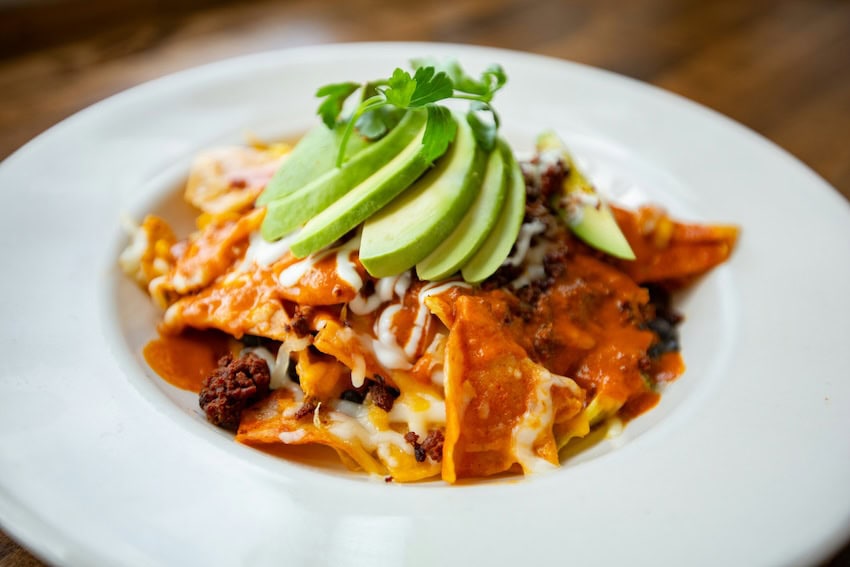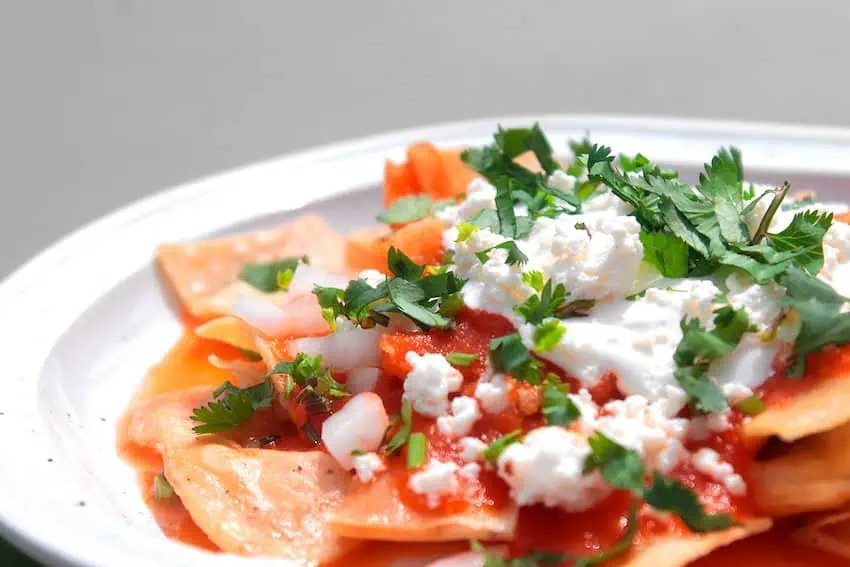Amigos, 80% of Mexicans experience intestinal issues (we didn’t make this up, this figure comes from research conducted by the National Institute of Medical Sciences and Nutrition).
Several factors contribute to this situation, including changes in our diet over the past few decades and increasingly sedentary and stressful lifestyles. Additionally, we cannot ignore that sometimes foods like chiles, tortilla dough, tamales, or tacos with too much salsa can leave us feeling bloated, as if we might roll around like pandas, accompanied by a mild discomfort in our stomachs, and yet we can’t stop eating them.

Today, we will talk about one of the most classic Mexican breakfasts. This dish is not only delicious but, when prepared correctly, can also be quite nutritious. Yes, we may regret overindulging, but blessed be the chilaquiles.
So, what are chilaquiles?
Chilaquilli
The origin of the word “chilaquil” is uncertain, but we do know that soaking hardened tortillas in sauce is a pre-Hispanic practice — and for good reason. Have you ever left a tortilla out in the open? You may have noticed how it hardens to the point that eating it becomes difficult — and sometimes even dangerous for your teeth. To salvage a hardened tortilla, the best solution is to soak it in sauce, making it edible again.
According to some etymological sources, the prefix “chil-” is derived from the Nahuatl word “chilli,” which means “chile” (bet you never guessed). A philologist once suggested that “aquili” translates to “inserted into something,” which could aptly describe the dish. So chilaquiles means “something inserted into chile”. While extremely accurate, it doesn’t do much to distinguish the contents from most of the rest of Mexican cuisine however, so it may not be a very useful name.
Chilaquiles
The current recipe for chilaquiles has evolved since pre-Hispanic times. Today, it is common to fry the tortillas, soak them in sauce, and top them with cheese, cream, onions, and some type of protein — ingredients that, as we’ve mentioned in previous articles, did not exist during pre-Hispanic times.
According to several sources, the first official record of this recipe appears in an 1828 cookbook titled “Arte nuevo de cocina y repostería acomodado al uso mexicano.” However, this recipe sounds very different from the version we know today. It begins with cooking pork and chorizo. Then, a ”clemole” (a type of mole) is prepared, to which tortillas, sesame seeds, and lard are added.
A few years later, the first cookbook published in an independent Mexico (1831) featured four chilaquiles recipes that more closely resemble the versions we have today. These include chilaquiles blancos, made by mixing red and green tomatoes, cooking them, adding tortillas, and topping with cheese, chorizo, pork ribs, or meat. There are also stuffed chilaquiles, small filled tortillas, as well as chilaquiles tapatíos.
Chilaquiles actuales
In every region of Mexico, the toppings for chilaquiles vary, but they are a staple everywhere. We eat them at celebrations such as “tornabodas” (the afterparty at weddings), baptisms, Sunday family breakfasts, and especially after a long night of cocktails and toasts.
If eating an entire plate of chilaquiles by yourself seems overwhelming, consider sharing them. If you’re concerned that the sauce might be too spicy, ask your waiter which option is milder, and to be safe, you can order extra cheese and cream on the side.

Even better, try making them at home!
If you ever find yourself with too many tortillas at home and aren’t sure what to do with them, try cutting them into triangles and letting them air-dry. In Mexico City, where the weather isn’t very hot, my tortillas typically take about 2 to 3 days to dry completely. This way, you can avoid frying them. If you prefer not to have tortillas drying around the house, you can simply cut them into triangles and fry them in vegetable oil. I usally cut and dry 10 tortillas.
Here are two salsa options so you can choose the one you like best. While you can always buy pre-made salsas, it’s best to adjust them according to your own spice tolerance.
Salsa Roja
Ingredients:
• 3 medium red tomatoes
• ¼ white onion
• 2 garlic cloves
• 1 tbsp fresh cilantro leaves
• 1½ tsp salt
• A pinch of ground black pepper
• 1 tsp oil
Instructions:
1. Boil the tomatoes, guajillo chile, onion, and garlic in water for 5–6 minutes until the tomatoes are soft.
2. Remove ingredients and reserve ½ cup of the cooking water.
3. Blend the cooked ingredients with cilantro, salt, pepper, and reserved water until smooth.
4. Heat oil in a saucepan, pour in the salsa, and simmer on medium-low heat for 2–3 minutes until slightly thickened.
5. Taste and adjust salt if needed. Add more water if too thick.
Salsa Verde
Ingredients:
• 6 tomatillos
• 1 serrano chile (seeded and deveined). If you want it mild, use a chile güero instead.
• ¼ white onion
• 2 garlic cloves
• 1 sprig fresh cilantro
• Salt to taste
Instructions:
1. Boil the tomatillos, serrano chile, onion, and garlic in enough water to cover them, for 5–6 minutes until the tomatillos change color and soften.
2. Remove ingredients and reserve ½ cup of the cooking water.
3. Blend the cooked ingredients with cilantro and salt until smooth.
4. If the salsa is too thick, add some of the cooking water until you reach the desired consistency.
5. Taste and adjust salt.
Pro tip: some people choose to skip the traditional salsas in favor of mole, guajillo salsa, or pasilla salsa to coat their tortilla chips, and these options are equally delicious.
Bring them together!
Once you have your salsa and tortilla chips prepared, feel free to add any toppings you like. For a breakfast option, shredded chicken or eggs are popular choices. If you prefer a plant-based version, consider using sautéed mushrooms, grilled tofu, avocado, or squash blossoms. Get creative with your toppings!
To serve: arrange your tortilla chips on a plate, whether they are fried or baked. Pour the salsa over the chips, add your desired toppings, and finish with cream, cheese, and onion if you prefer.Prepared this way, they shouldn’t upset your gut or leave you with a rolling feeling like a panda.
Amigos, this Sunday, join us in our chilaquiles tradition by making them at home and ejoying them with your loved ones.
Do you have a favorite recipe for chilaquiles? Do you eat them often?
María Meléndez is a Mexico City food blogger and influencer.




